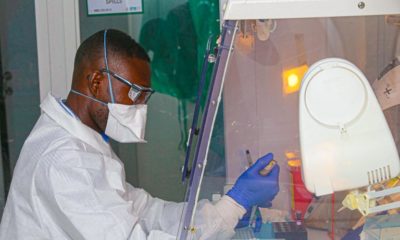News
As Monkeypox spreads across 7 states, Here are things you should know about the Disease
The Nigeria Centre for Disease Control (NCDC) says 31 suspected cases of monkey pox have so far been reported in seven states across the country.
Dr Chikwe Ihekweazu, the National Coordinator/Chief Executive Officer of NCDC, made this known on Monday in Abuja.
According to Ihekweazu, following the notification of a suspected monkeypox outbreak in Bayelsa on September 22, 2017, other suspected cases have been reported from six more states.
He listed the affected states as Bayelsa, Rivers, Ekiti, Akwa Ibom, Lagos, Ogun and Cross Rivers.
Ihekweazu said that samples had been collected from each suspected case for laboratory confirmation.
“Results are still being awaited. So far, there have been no deaths recorded. It is unlikely that many of the suspected cases are actually monkey pox, but all are being investigated. All the suspected cases are currently receiving appropriate medical care, and the patients are all improving clinically in their various states,’’ he said.
Ihekweazu said that the Federal Ministry of Health, through the Nigeria Centre for Disease Control (NCDC), is supporting the affected states to ensure the outbreak is brought under control and to limit further spread.
Things you should know about the disease
Monkeypox is a rare disease that is caused by infection with monkeypox virus. The disease, which is a similar to but milder than Smallpox, is transmitted to people from various wild animals. It however, has limited secondary spread through human-to-human transmission.
It was first reported in 1970 in the Democratic Republic of Congo (then known as Zaire) in a 9 year old boy who lived in a region where smallpox had been eradicated 2 years prior.
It was also reported in Midwest U.S in 2003 and most patients, it was discovered, had had close contact with pet prairie dogs.
According to the U.S Centre for Disease Control, the natural reservoir of the disease remains unknown, however, some rodent species are expected to play a role in its transmission.
World Health Organisation (WHO) reports that the infection has been found in many animal species: rope squirrels, tree squirrels, Gambian rats, striped mice, dormice and primates.
Transmission
- Through direct contact with the blood, bodily fluids, or handling of infected animals.
- Eating infected animals is also another risk factor.
- Human-human transmission is through infected respiratory tract secretions and skin lesions of an infected person or objects recently contaminated by patient fluids or lesion materials.
Here are some ways to prevent its spread:
- Avoid contact with animals that could harbor the virus (including animals that are sick or that have been found dead in areas where monkeypox occurs).
- Avoid contact with any materials, such as bedding, that has been in contact with a sick animal.
- Isolate infected patients from others who could be at risk for infection.
- Practice good hand hygiene after contact with infected animals or humans. For example, washing your hands with soap and water or using an alcohol-based hand sanitizer.
- Use personal protective equipment (PPE) when caring for patients.
Signs and symptoms of the disease include: Fever, Headache, Muscle aches, Backache, Swollen lymph nodes, Chills, Exhaustion. These signs occur between 0 – 5 days of contracting the disease.
After about 1 – 3 days of appearance of fever, the patient begins to develop rashes which starts from the face and spreads to several parts of the body.
Treatment
There is no proven treatment for the disease, however, smallpox vaccine, antivirals, and vaccinia immune globulin (VIG) can be used in controlling its spread.
**
Please do well to report any of the above symptoms to the nearest appropriate medical centre as well as make sure the preventive measures listed above are taken.
Photo Credit: Wikipedia























